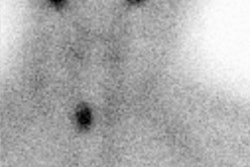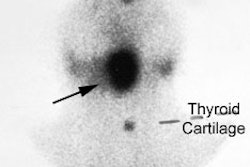Other Thyroid Conditions
Factitious Hyperthyroidism
Factitious hyperthyroidism occurs when a patient ingests thyroid hormone in sufficient quantities to induce a thyrotoxic state. Thyroglobulin levels are also low or undetectable in facticious hyperthyroidism, while other forms of hyperthyroidism will demonstrate normal or elevated thyroglobulin levels. These patients will have decreased RAIU and poor uptake of tracer on thyroid exams.
If T3 alone is ingested, serum T4 is usually depressed as a result of inhibition of thyroid secretion secondary to T3 suppression of TSH. The low T4 values are in contrast to the normal T4 values expected with true T3 toxicosis.
Euthyroid Sick Syndrome
The most common abnormality of thyroid function tests in sick patients is low T3 syndrome. The low serum T3 levels in patients with nonthyroidal illness reflect the impaired peripheral conversion of T4 to T3 primarily due to the reduced activity of the type 1, 5'-deiodinase enzyme. In addition, T3 binding to serum proteins may be decreased with increased metabolic clearance of T3. Levels of reverse T3 which has no metabolic activity are elevated mainly due to decreased clearance rate. As the severity of the illness increases, total T4 values may decline as a result of decreased thyroid binding globulin concentration or the presence of inhibitors of T4 binding to TBG. The changes in binding protein concentration and affinity are reflected by an elevated T3 uptake test, with a calculated FT4I in the low normal range and a free T4 concentration that is in the normal range depending on the assay used (refer to section on thyroid function tests). TSH levels are usually normal. It is felt that the low T3 and T4 levels are a physiologic adaptation to the illness and that these patients are actually euthyroid. The degree of deviation from normal values correlates significantly with the patient mortality.
Amiodarone Associated Thyroid Disease
Amiodarone is an antiarrhythmic cardiac drug rich in iodine (75 mg of iodine per 200 mg tablet). The agent can be associated with iodine-induced thyroid dysfunction [1]. Hypothyroidism can be seen in 20% of patients and is associated with the presence of anti-thyroid peroxidase antibodies [1].
Hypothyroidism
Primary Hypothyroidism
Primary hypothyroidism is due to an endogenous thyroid disorder. The most common cause of hypothyroidism in adults is Hashimoto's thyroiditis. Asymptomatic hypothyroid patients typically have low normal T4 values and normal T3 values, but markedly elevated TSH levels. Once patients become symptomatic, both T3 and T4 levels are decreased. Levels of reverse T3 are also decreased. Thyroid nuclear imaging studies are of no value in establishing the diagnosis of primary hypothyroidism. In the past, TRH stimulation test was often performed to diagnose primary hypothyroidism as these patients exhibit an exaggerated TSH response. However, this test does not add any useful information since an elevated TSH level in patients with low serum T4 values is diagnostic for primary hypothyroidism.
Secondary Hypothyroidism
Secondary hypothyroidism is the result of decreased TSH production due to pituitary disease. The TRH stimulation test in secondary hypothyroidism classically yields a flat TSH response, but may be quite variable. The diagnosis should be suspected in patients who are hypothyroid that present with low serum T4 or T3 concentrations but with a serum TSH level that is low or inappropriately normal. Treatment should be directed at the pituitary gland which may involve surgical removal of a pituitary tumor or replacing deficient pituitary hormones (in particular, steroid replacement prior to thyroid hormone replacement to avoid precipitating an adrenal crisis).
Tertiary Hypothyroidism
Tertiary hypothyroidism is the result of decreased TRH production secondary to a hypothalamic disorder. Classically, there is a delayed TSH response to TRH stimulation in these patients with a peak serum level 60 to 180 minutes after TRH administration although the results may be quite variable. Central hypothyroidism should also be suspected in hypothyroid patients with inappropriately low or normal TSH levels. Management is similar to patients with secondary hypothyroidism and be directed at identifying the hypothalamic lesion.
REFERENCES:
(1) Radiographics 2001; Intenzo CM, et al. Scintigraphic features of autoimmune thyroiditis. 21: 957-964




